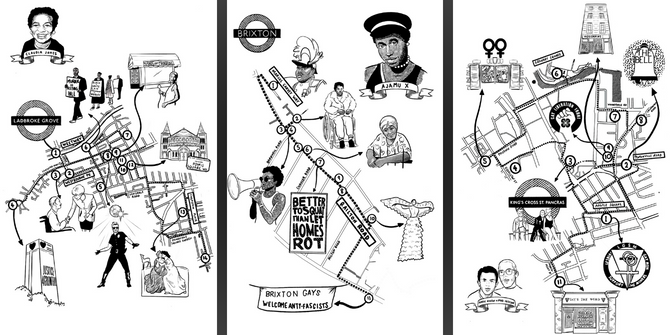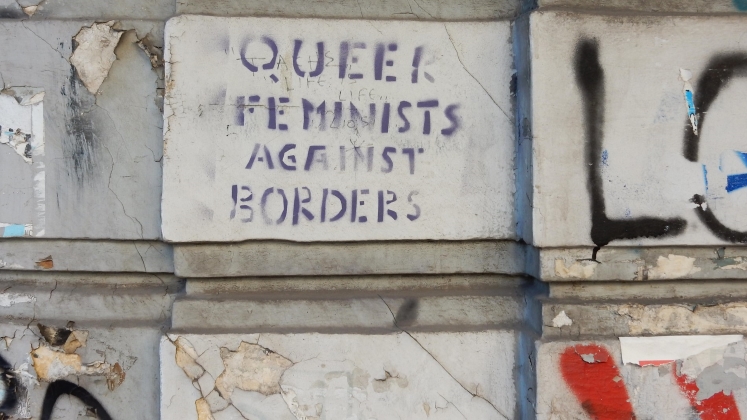In Long Live Queer Nightlife, Amin Ghaziani charts the transformation of LGBTQ+ nightlife in recent decades amid venue closures and gentrification, focusing on London. Through a blend of personal anecdotes and academic insights, the book is a celebration of the resilience and reinvention of queer spaces, emphasising their vital role in fostering community, inclusivity, and radical joy, writes Max Shirley.
 Amin Ghaziani, a professor of sociology, opens Long Live Queer Nightlife with a familiar anecdote. In the preface, titled “Buttmitzah”, Ghaziani recalls attending a queer Jewish event where he was given a bagel upon arrival. Both literally and metaphorically, queer nightlife is a form of sustenance. This initial scene typifies the experience of partaking in such ephemeral and communal events. Indeed, when reading Ghaziani’s book I saw echoes of my own experiences, such as during a long weekend in Valencia where friends and I followed locals from a bar to a club to watch dancers, dressed as matadors, descend from the central stage with platters of jamon as we sweated through the night.
Amin Ghaziani, a professor of sociology, opens Long Live Queer Nightlife with a familiar anecdote. In the preface, titled “Buttmitzah”, Ghaziani recalls attending a queer Jewish event where he was given a bagel upon arrival. Both literally and metaphorically, queer nightlife is a form of sustenance. This initial scene typifies the experience of partaking in such ephemeral and communal events. Indeed, when reading Ghaziani’s book I saw echoes of my own experiences, such as during a long weekend in Valencia where friends and I followed locals from a bar to a club to watch dancers, dressed as matadors, descend from the central stage with platters of jamon as we sweated through the night.
Ghaziani, a self-styled “urban ethnographer of nightlife”, began work on Long Live Queer Nightlife in 2018, during a sabbatical period which saw him relocate from Vancouver to London (9). The so-called “closure epidemic” – a term coined by Samuel Douek – was already in full swing with 58 per cent of all LGBTQ+ bars, clubs, and pubs in the UK’s capital shuttering between 2006 and 2016 (2). A similar trend can be seen in major Western cities across the globe, and the situation has only been exacerbated by the COVID-19 pandemic and resulting lockdowns.
Gone are the days of weekly club nights in fixed locales such as Soho; now the queer scene is taking place farther afield, in car parks and warehouses, working men’s clubs and community spaces.
The situation looks bleak, and these statistics are often met with outcry. But the decline in brick-and-mortar establishments is not necessarily fatal, according to Ghaziani. Queer nightlife is being reborn in new, disruptive ways. And this is what Ghaziani focuses on in Long Live Queer Nightlife – not the facts and figures of commercial closures, but the emergence and persistence of new forms of life after dark. Ghaziani’s new book can be placed in a growing lineage of queer nightlife texts, such as the McKenzie Wark’s excellent and recently published text, Raving. The events both authors examine are fleeting and fast, taking place on an irregular basis at new and mobile locations. Gone are the days of weekly club nights in fixed locales such as Soho; now the queer scene is taking place farther afield, in car parks and warehouses, working men’s clubs and community spaces.
Long Live Queer Nightlife is an accessible introduction to the cultural world of LGBTQ+ communities when the sun goes down. Ghaziani alternates academic chapters – filled with stats, interviews, and necessary context – and autobiographical digressions, recounting his own experience dipping into London’s queer nightlife scene. The text begins with a brief discussion of the socio-economic factors behind the closure epidemic – namely, increasing land values and gentrification – before Ghaziani attends to the where, why, and how of the new emerging queer scene. The sociologist is accompanied by a recurring cast of characters and interlocutors throughout the book, including the artist-scholar and DJ madison moore, who bolster his argument with expert insights and observations.
Ghaziani emphasises feeling, sensation, and the affective force of nightlife over its numerical and statistical representation.
Central to the text is Ghaziani’s commitment to the world-making power of queer nightlife. Thinking through the work of the late queer studies scholar José Esteban Muñoz, Ghaziani highlights the radical potential of partying: “Nightlife is transformative for people who are marginalized by multiple vectors of power, as it enables unique ways of seeing and being in the world” (7). In the text’s conclusion, Ghaziani pithily summarises the political implications of queer nightlife, noting how it creates space for belonging and joy, in addition to allowing LGBTQ+ individuals to “connect with our history, who we are, where we are, where we want to be” (200). This is to say that Ghaziani emphasises feeling, sensation, and the affective force of nightlife over its numerical and statistical representation.
With this focus on affect and feeling in mind, Ghaziani delineates a series of concepts that emerge from the spaces and places of nightlife. Some of these theoretical observations – such as the focus on the world-making potential discussed above – are stylishly and concisely elucidated. Nevertheless, other sections of the text are less successful. For instance, toward the end of his book, Ghaziani argues for the potential of queer nightlife to “reorient” the body (146). Though Ghaziani does reference Sara Ahmed’s essay “An Affinity of Hammers” in this section, a discussion of her seminal text on bodily orientations, Queer Phenomenology, might have enabled him to push this notion of reorientation further. Bringing other theorists and thinkers into the text, in addition to Muñoz, would have enlivened the more conceptual elements of the book.
LGBTQ+ spaces are vital and community driven. Indeed, perhaps the most important aspect of queer nightlife that Ghaziani discusses is its response to the overrepresentation of whiteness.
Long Live Queer Nightlife does do well to highlight specific case studies and examples of queer activism. For example, Ghaziani discusses the ongoing work of the Friends of the Joiners Arms and their campaign to save historic the queer pub (100). LGBTQ+ spaces are vital and community driven. Indeed, perhaps the most important aspect of queer nightlife that Ghaziani discusses is its response to the overrepresentation of whiteness. In an insightful chapter titled “A Core of Whiteness”, Ghaziani explores the intersectional failures of traditional gay bars which often have an overwhelming white and homonormative clientele. “Club nights” Ghaziani writes, “represent an intentional and radically inclusive vision for nightlife” where queers of colour can find refuge and community (136).
If you truly want an insight into contemporary queer nightlife, then you need to get out there and experience it for yourself.
Many readers will find community in this book. The autobiographical additions to Long Live Queer Nightlife echo this notion as Ghaziani follows friends around London, experiencing moments of queer joy and collectivity. Yet, it is in the academic chapters of the text – which weave together interviews and scholarship –where Ghaziani’s new work shines. Perhaps this goes to show that, if you truly want an insight into contemporary queer nightlife, then you need to get out there and experience it for yourself.
Note: This review gives the views of the author and not the position of the LSE Review of Books blog, nor of the London School of Economics and Political Science.
Image credit: cktravels.com on Shutterstock.







